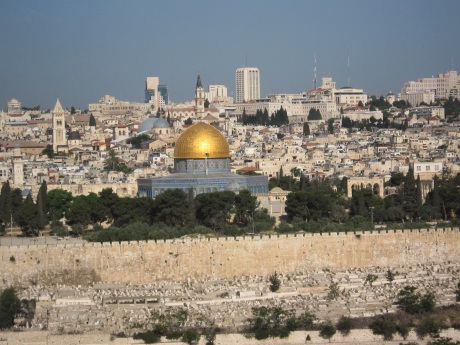Girls wearing traditional Palestinian clothes mark Nakba Day in Bethlehem.
It was June 6, 1973. I was travelling to the Occupied West Bank—Palestine. It was during the anniversary of the Six-Day War of 1967. I was the only white person on the flight. And I was with a Palestinian—my fiancé, Adnan, a Muslim student I had met at the University of Toronto.
We arrived in Tel Aviv at 5 a.m. When the plane landed, two police officers came striding down the aisle and stopped at our seats. They took our passports and escorted us off the plane. I was taken down to one end of the tarmac and Adnan to the other. I was strip-searched with three automatic rifles pointed at me.
Welcome to Israel.
This was the first of many visits.
In October 2010, when I signed up to go on a church-led mission study tour to Israel-Palestine, I was excited to read about the places we would visit. I had been to every one of them when I lived there in the ‘70s!
My arrival in Tel Aviv on May 9, 2011 was less traumatic than the first time!
What changes did I see? The women were well dressed with beautifully tailored long coats; they wore their hijabs with dignity and style; their eyes sparkled and there were ready smiles on their lips. Whenever possible, I spoke with them in Arabic and every time I was greeted warmly and with eye contact. This would never have been the case 30 years ago when no woman, including me, was allowed out alone and would have been drably dressed with her hijab pulled down over most of her face. She would never have spoken with a stranger, let alone made eye contact.
There was a peaceful demonstration by youth to mark Nakba Day (May 15, a day to remember the displacement of Palestinians following Israel’s Declaration of Independence in 1948). Women were among the demonstrators—another change. Today woman are participating in and discussing politics.
A lot is happening in Palestine and Israel and much of it is good. There are programs for religious leaders, women and young adults being organised by the Interreligious Coordinating Council in Israel. They are building peace through education and action.
The Ecumenical Accompaniment Programme in Palestine and Israel uses non-violent action and advocacy to try and bring a just peace to the Holy Land. Then there’s B’Tselem, an Israeli human rights organization that acts primarily to change Israeli policy in the Occupied Territories, to ensure that its government protects the human rights of residents and complies with its obligations under international law. Sabeel, an ecumenical liberation theology movement among Palestinian Christians, strives to develop a spirituality based on justice, peace, non-violence and reconciliation for the different national and faith communities.
There is hope and it is showing. There is communication. There is dialogue and there is, at times, harmony.

The Dome of the Rock in Jerusalem.
This experience has been life-changing for me. During our time in Jerusalem, we walked the roads that Jesus walked in the Old City. We entered through the Lion Gate, into the Muslim Quarter, visited the Wailing Wall in the Jewish Quarter, continued along the Via Dolorosa to the Church of the Holy Sepulchre. To walk in these ancient streets where so many have lived for thousands of years was awesome! One constant memory from living in Nablus was the markets of the Old City—the noise, the smells, the colours—and I was overjoyed to experience that whole engagement of the senses again.
I walked in Manger Square to the Nativity Church in Bethlehem. I went to Tiberius, stopped at the head of the River Jordan, and then went on to the Sea of Galilee. Our group danced and sang on a boat in the rain under the Golan Heights.
In the ‘70s, I lived and travelled with Palestinian Muslims. We were never allowed to visit much of this area. There were and still are places where Palestinians are not allowed to be. Palestinians carry permits; they are stopped numerous times going through checkpoints in their own cities; they have their bags checked during this humiliating experience. This is much worse now than it was then.
Having seen many of the tourist attractions, which are mostly ancient, religious, and far more numerous than when I lived there, I understood how privileged I was during this visit with Christians. I realized how much the Palestinians are not allowed to see. This is, in part, due to the rise of the separation wall being built by the Israelis. We made a visit to this monstrosity and we wept. It brought us to silence. Palestinian families have lost their homes and their olive trees. They are no longer able to visit with family if they live on the other side of the wall. It is a terrible sight. We prayed. This wall was never imagined all those years ago.
What will be the final outcome? Will a just peace ever be put in place in Palestine and Israel? Will the Christians in the world take time to go and see for themselves what is happening there? Will the plea for help, written in the Kairos Palestine Document, be heard? Let’s hope and pray that this will be so. The Christian Palestinians I met were serene, calm and certain that God will prevail, allowing Christians, Muslims and Jews to live together. I sensed strength in men and women willing to persevere, dialogue and work with the young people to make a difference. This would not have been the case back in the ‘70s. The anger of the earlier years no longer crackles in the air. There is hope. However, there is also weariness of war and this has to change. It will change very slowly but it will happen. Of this I am sure.

